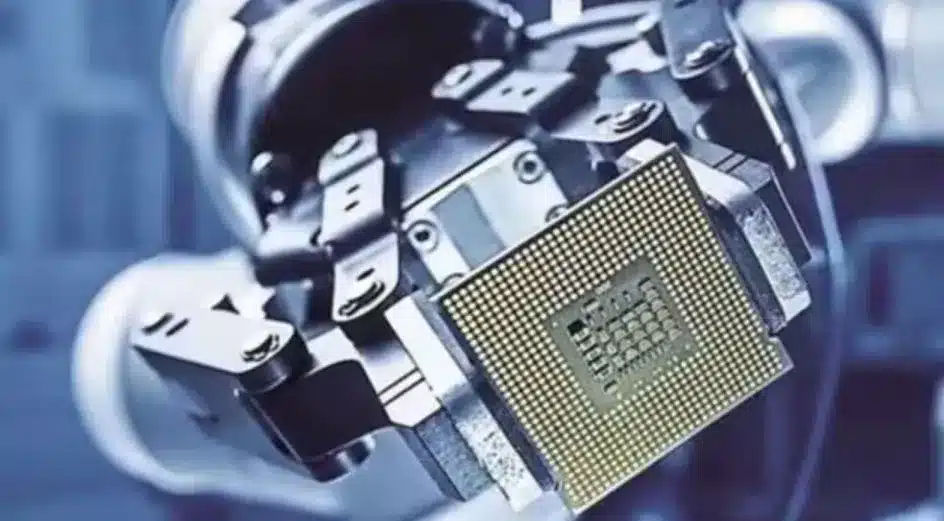What’s in today’s article?
- Why in News?
- Semiconductor manufacturing in India
- Chip assembly plant in Gujarat
Why in News?
The union cabinet, chaired by PM Modi, has approved the proposal of Kaynes Semicon to set up a semiconductor unit in Gujarat with an investment of INR 3,300 Cr. This is the fifth semiconductor unit, and the fourth assembly unit, to receive Cabinet approval.
The proposal was approved under the India Semiconductor Mission (ISM).
Semiconductor manufacturing in India
- Need for domestic manufacturing of semiconductors
- Foundation stone of modern electronics industry
- Semiconductors and displays are the foundation of modern electronics industry.
- These are critical components that power electronics – from computers and smartphones to the brake sensors in cars.
- To reduce import dependency
- As India does not produce any semiconductors, the country’s demands are met with imports.
- The demand for semiconductors in India will reportedly reach around USD 100 billion by 2025, up from the current demand of USD 24 billion.
- To overcome the disruption in supply-chain
- The absence of local manufacturing affected India the most during the lockdown imposed due to the Covid-19 pandemic.
- Geopolitical significance
- In the current geopolitical scenario, trusted sources of semiconductors and displays hold strategic importance.
- These are key to the security of critical information infrastructure.
- E.g., The Department of Telecommunications has in the past raised concerns over possible bugs in the telecom equipment sold by the Chinese company.
- Steps taken by the Govt to promote indigenous semiconductor industry
- India Semiconductor Mission (ISM)
- Launched in 2022, ISM aims to establish a robust semiconductor ecosystem within the country.
- This initiative, housed under the Digital India Corporation, is tasked with catalysing semiconductor manufacturing, packaging, and design capabilities in India.
- As an independent business division, the ISM possesses the necessary administrative and financial autonomy to drive the program’s efficient implementation.
- Moreover, it boasts an advisory board comprising leading global experts in the semiconductor domain, ensuring strategic guidance and expertise.
- SemiconIndia Programme
- The Union Cabinet approved the Semicon India Programme in 2021 with a budget of INR 76,000 crore.
- The program aims to create a sustainable semiconductor and display ecosystem in India.
- It does so by offering attractive incentives to companies involved in various semiconductor-related sectors, including Silicon Semiconductor Fabs, Display Fabs, Compound Semiconductors, Sensors, and Semiconductor Packaging.
- Design Linked Incentive (DLI) Scheme
- Uder this, support is provided to 100 domestic companies of semiconductor design for Integrated Circuits (ICs), Chipsets, System on Chips (SoCs), etc.
- The Centre for Development of Advanced Computing (CDAC) is the nodal agency for implementing the DLI Scheme.
- Modified Scheme for Setting up of Semiconductor Fabs
- The Modified Scheme for Setting up of Semiconductor Fabs in India provides a 50% fiscal support of the project cost for the setting up of semiconductor fabs in India.
- This scheme is part of the Semicon India program.
- Fiscal Support
- The Central Government has announced incentives for every part of supply chain including electronic components, sub-assemblies, and finished goods.
- In total, Government has committed support of Rs. 2,30,000 crore (USD 30 billion) to position India as global hub for electronics manufacturing with semiconductors as the foundational building block.
- Chips to Startup (C2S) programme
- The government has also introduced the Chips to Startup (C2S) programme aims to train 85,000 engineers (Bachelors, Masters and Research level combined) qualified in ESDM disciplines over a period of 5 years.
- ESDM – Electronic System Design and Manufacturing
- The government has also introduced the Chips to Startup (C2S) programme aims to train 85,000 engineers (Bachelors, Masters and Research level combined) qualified in ESDM disciplines over a period of 5 years.
- India Semiconductor Mission (ISM)
- Foundation stone of modern electronics industry
Chip assembly plant in Gujarat
- About the news
- In a significant move towards building a robust semiconductor ecosystem, the Union Cabinet approved the proposal for Kaynes Semicon Pvt Ltd to establish a semiconductor manufacturing unit in Sanand, Gujarat.
- This initiative, which involves an investment of ₹3,300 crore, is expected to enhance India’s semiconductor production capabilities.
- Key highlights of the plant
- The capacity of this unit will be 60 lakh chips per day.
- The chips produced in this unit will cater to a wide variety of applications which include segments such as industrial, automotive, electric vehicles, consumer electronics, telecom, mobile phones, etc.
- India’s ambitions to become a major chip hub
- India is striving to become a major semiconductor hub, similar to the United States, Taiwan, and South Korea, by attracting foreign companies to establish operations within the country.
- Notably, India has approved an $11 billion fabrication plant by Tata Electronics in partnership with Taiwan’s Powerchip and three chip assembly plants by Tatas, US-based Micron Technology, and Murugappa Group’s CG Power with Japan’s Renesas.
- Additional proposals include a ₹78,000-crore fabrication plant by Israel’s Tower Semiconductor and a ₹4,000-crore assembly plant by Zoho, highlighting the country’s growing ambitions in the semiconductor industry.
Q.1. What is the significance of the ₹3,300-crore chip assembly plant in Gujarat?
The ₹3,300-crore chip assembly plant in Gujarat is a crucial step towards building a robust semiconductor ecosystem in India, reducing import dependency, and positioning India as a global chip manufacturing hub.
Q.2. How does the India Semiconductor Mission support the semiconductor industry?
The India Semiconductor Mission supports the semiconductor industry by offering financial incentives and fostering a sustainable ecosystem for semiconductor manufacturing, packaging, and design in India.
Source: Cabinet OKs `3,300-cr chip assembly plant in Gujarat | PM India | India Semiconductor Mission | PIB | Economic Times
Last updated on December, 2025
→ Check out the latest UPSC Syllabus 2026 here.
→ Join Vajiram & Ravi’s Interview Guidance Programme for expert help to crack your final UPSC stage.
→ UPSC Mains Result 2025 is now out.
→ UPSC Notification 2026 is scheduled to be released on January 14, 2026.
→ UPSC Calendar 2026 is released on 15th May, 2025.
→ The UPSC Vacancy 2025 were released 1129, out of which 979 were for UPSC CSE and remaining 150 are for UPSC IFoS.
→ UPSC Prelims 2026 will be conducted on 24th May, 2026 & UPSC Mains 2026 will be conducted on 21st August 2026.
→ The UPSC Selection Process is of 3 stages-Prelims, Mains and Interview.
→ UPSC Result 2024 is released with latest UPSC Marksheet 2024. Check Now!
→ UPSC Prelims Result 2025 is out now for the CSE held on 25 May 2025.
→ UPSC Toppers List 2024 is released now. Shakti Dubey is UPSC AIR 1 2024 Topper.
→ UPSC Prelims Question Paper 2025 and Unofficial Prelims Answer Key 2025 are available now.
→ UPSC Mains Question Paper 2025 is out for Essay, GS 1, 2, 3 & GS 4.
→ UPSC Mains Indian Language Question Paper 2025 is now out.
→ UPSC Mains Optional Question Paper 2025 is now out.
→ Also check Best IAS Coaching in Delhi

















